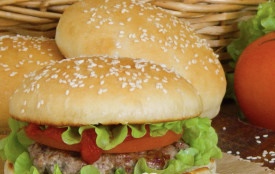



Do you like fast food and can't imagine life without burgers? Then my today's recipe for hamburger buns will definitely come in handy! After all, it is not at all necessary to buy these delicious and hearty sandwiches in fast food establishments - they can be easily prepared at home from simple and affordable products.
According to this recipe, buns for hamburgers are not only very tasty, aromatic, but also beautiful - you can hardly distinguish them from purchased ones. The delicate, uniformly porous, fine-mesh crumb is hidden under the thinnest, soft crust covered with sesame seeds. By the way, such buns retain their freshness for a long time, and they also tolerate freezing well, so they can be prepared for future use.
We will make the dough for hamburger buns in a sponge way. This amount makes 6 delicious round beauties, so if you need more, double the proportions. But then you have to bake homemade hamburger buns in two passes, since no more than 6 pieces fit on one baking sheet.

Do you like fast food and can't imagine life without burgers? Then my today's recipe for hamburger buns will definitely come in handy! After all, it is not at all necessary to buy these delicious and hearty sandwiches in fast food establishments - they can be easily prepared at home from simple and affordable products.
According to this recipe, buns for hamburgers are not only very tasty, aromatic, but also beautiful - you can hardly distinguish them from purchased ones. The delicate, uniformly porous, fine-mesh crumb is hidden under the thinnest, soft crust covered with sesame seeds. By the way, such buns retain their freshness for a long time, and they also tolerate freezing well, so they can be prepared for future use.
We will make the dough for hamburger buns in a sponge way. This amount makes 6 delicious round beauties, so if you need more, double the proportions. But then you have to bake homemade hamburger buns in two passes, since no more than 6 pieces fit on one baking sheet.
Sign up to receive email updates on new recipes.